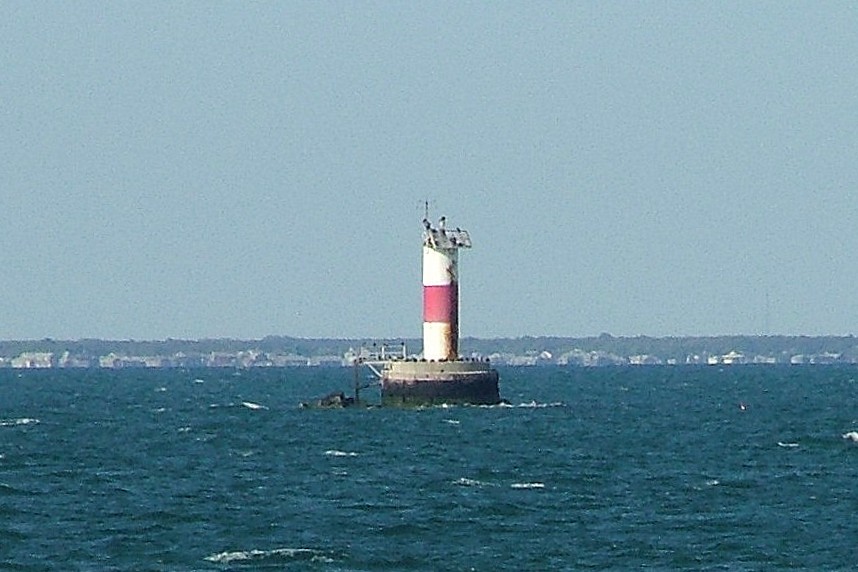|
| |||
|
|
|
Bishops and Clerks Lighthouse 1858 - 1952 (a Nantucket Sound Landmark for many years) 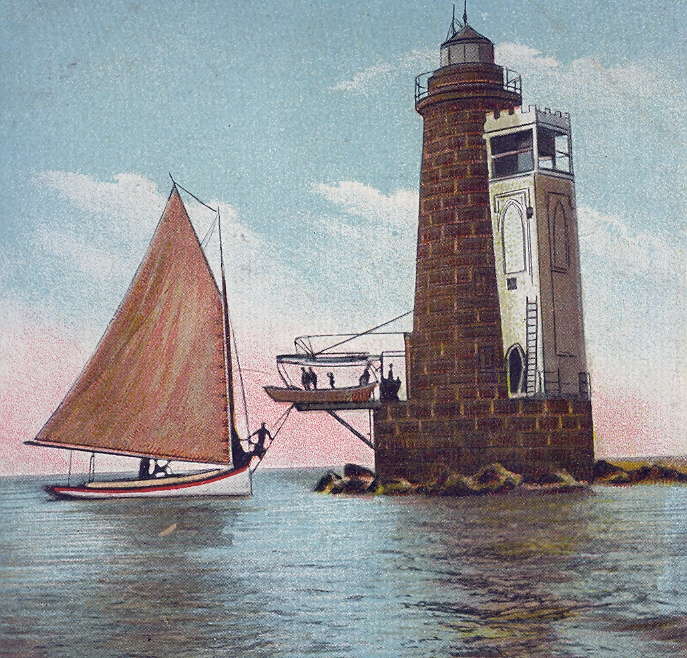 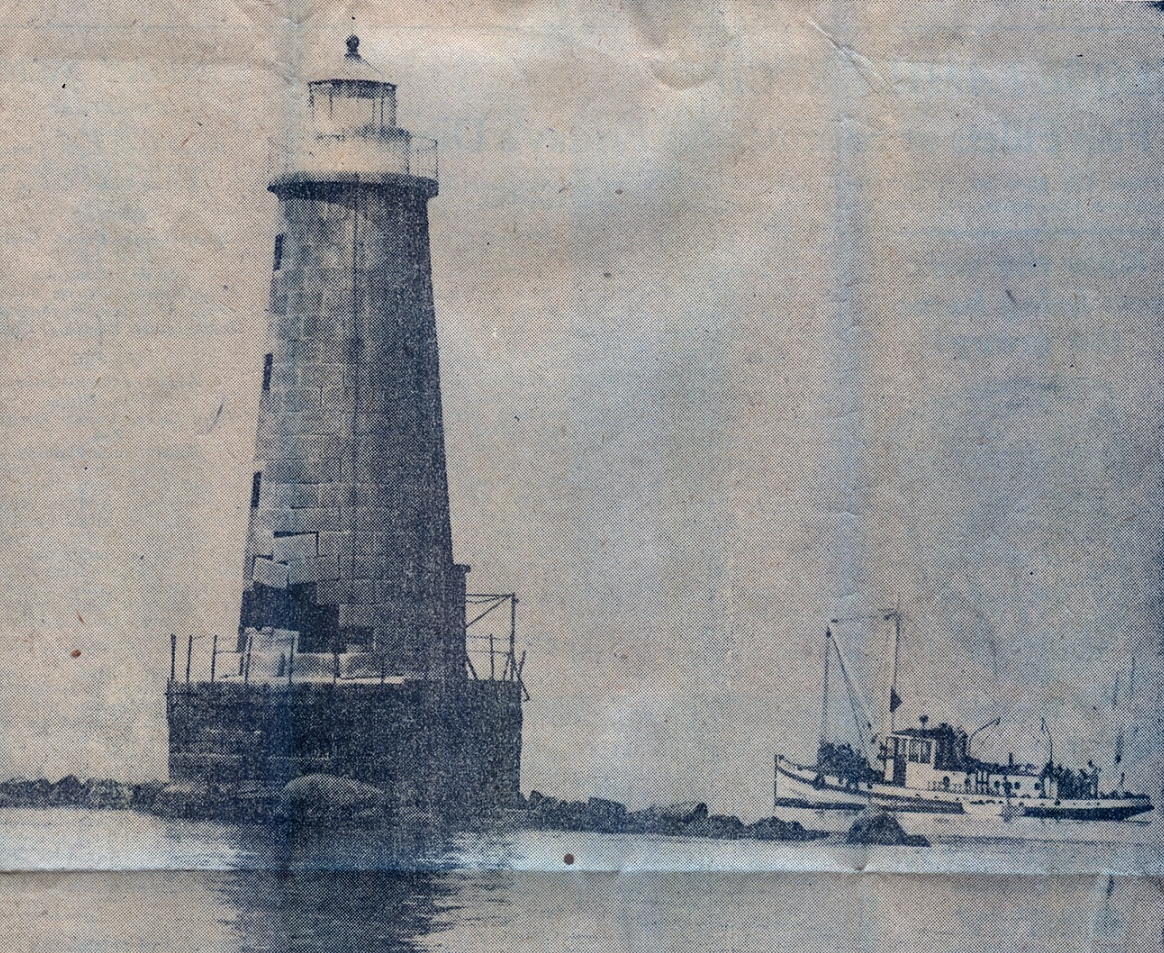
HYANNIS PORT,
Sept. 11th
The 94-year-old Bishop and Clerks Lighthouse, long a familiar landmark to
mariners and vacationers, vanished in a thunderous blast of dynamite at 12:57 p.
m. today.
The 68-foot tower, unused as a beacon since a storm damaged it in 1938, was
demolished under direction of the Coast Guard, which had judged it unsafe.
Scores of pleasure craft bobbed and circled at a safe distance as Summer folk
sadly watched the light's destruction which they had protested in vain.
Workmen had labored ,since sunup this morning, placing dynamite sticks in 68
holes bored in the granite base of the tower.
At three minutes before 1, John Parmenter of Brockton set off the charge from a
dory 1000 feet away.
A cloud of smoke partly hid the old tower, which stood swaying for a moment and
then toppled to one side like a pile of child's blocks.
All that remained above the base was a heap of rubble that still held in place a
two-foot slab of granite, imprinted with the date 1858, which had stood over the
door of the lighthouse.
The tower stood- on a
ledge, exposed at low tide, off Point Gammon, five miles at sea from this town.
A 3'O-foot "day beacon" is to be built on
the
base.
U. O. MacDonald of Boston, drilling and blasting specialist, handled the
demolition. It was a difficult job, he said, because he had to preserve the base
of the tower, and because the debris had to be made to fall on the ledge, so
that it could be salvaged for future use. MacDonald had little bags of sand
placed under each dynamite stick to direct the blast upward.
A week of preparations had been made by the McKie Lighter, Company of Boston,
hired by the government for, the job. Everything worked out exactly as planned.
Warren E. Moore, an inspector for the Coast Guard, was there in a supervisory
capacity.
The tug Irene and Mary, on the scene, flew a red warning dynamite flag. A
government craft kept sightseers at a safe distance.
When they were ready to blast, the tug blew six warning blasts on her whistle.
Ten seconds later the explosion came.
The historic Bishop and Clerks Lighthouse was
no more.
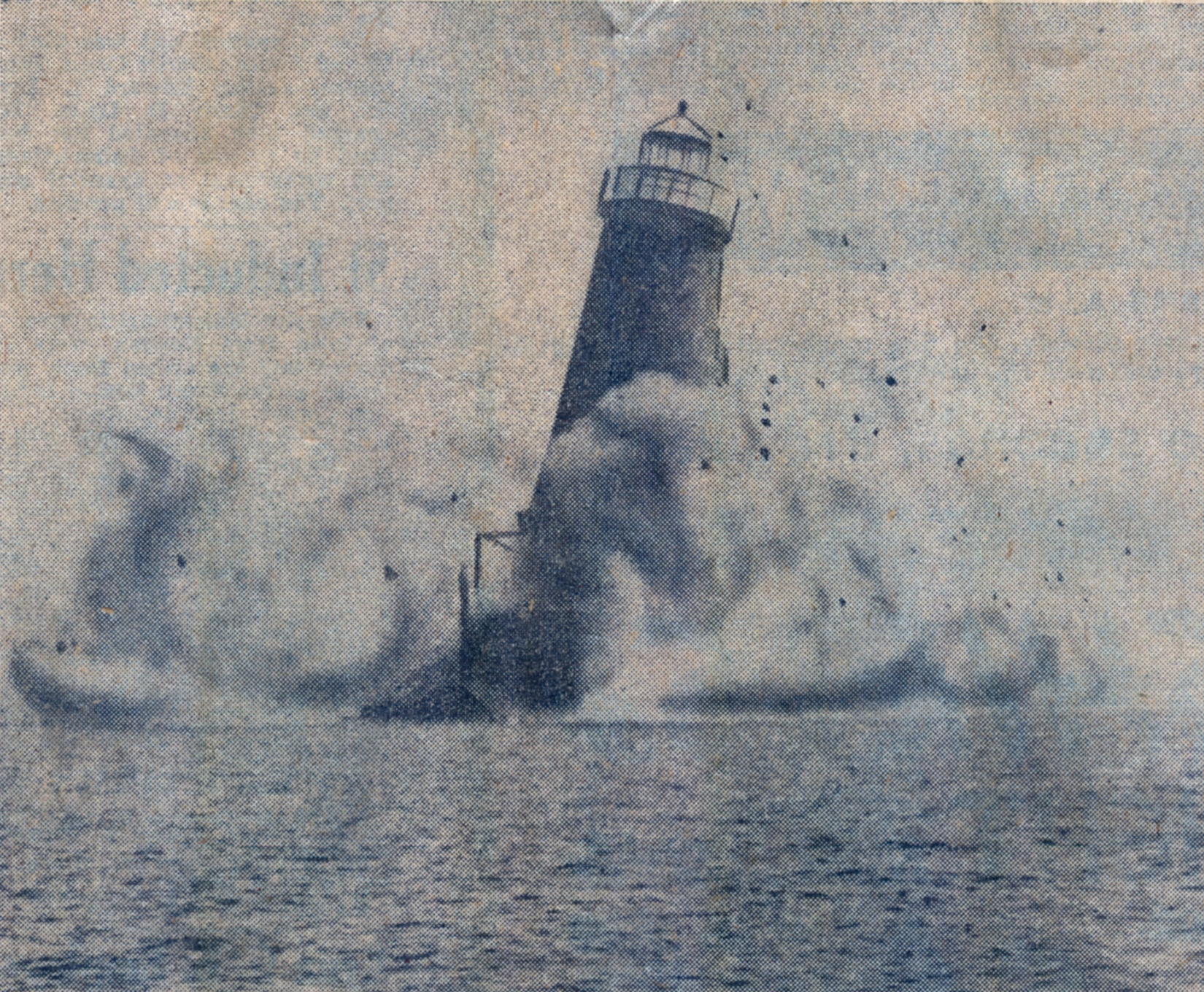 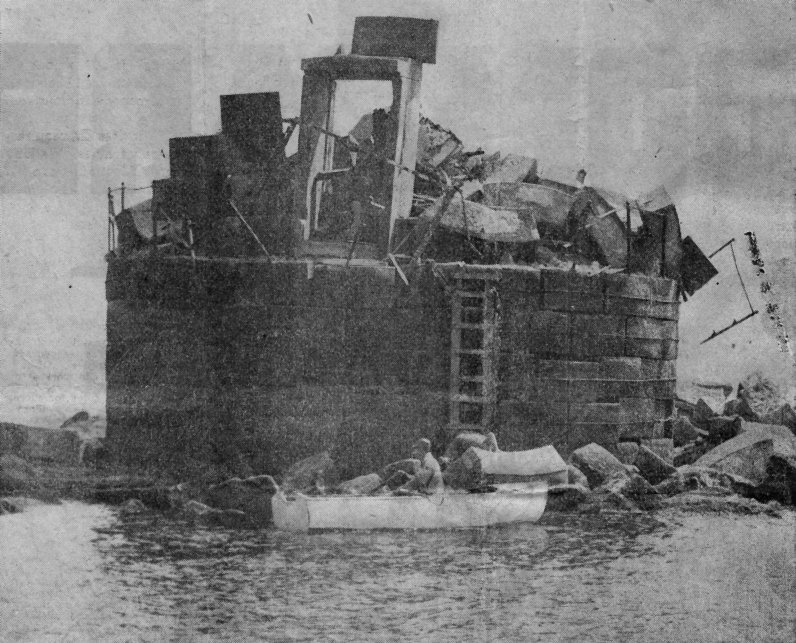
The Passing
of Bishops"
Light
When the
96-year-old
Bishop
and
Clerks
Lighthouse,
unused
for
several
years,
was destroyed
by
a blast
of
200
pounds
of dynamite
last
Thursday,
something
more
than a tower
of
stone,
mortar and
steel
crumpled
and
fell
into
the
sea.
Another
staunch
reminder
of
the
Great Sailing
Ship
Era disappeared
from the
horizon and
to
many
of
us
who
from boyhood
watched
the
then
revolving
light
at
night,
became
accustomed
to using the
tower
itself
as a range
for fishing
and
sailing
by
day,
as well
as
a constant
reminder,
in all kinds
of
weather,
of the
treacherous
ledge
it was
originally
erected
to
mark,
comes
the
sensation
of losing
a good and faithful friend.
From the
mouth of the
River,
the
horizon looks different
and lonely
now,
as
one
looks
off to the
southwest.
As the
eye
travels
from Point
Gammon
off to the
South,
the gray tower is
no
longer
there.
.
True,
it had
become
unsafe,
and the Coast Guard had no other
recourse
but to demolish
and replace
it with a modern
marking device which together with the buoying on
all
sides
will
meet
present
day
needs
of water
travel
in that section.
This is once
more
evidence
of the
certainty
of "change"
as a part
of Life.
Yet nothing is to prevent our preserving
a bright
image of "dear
old.
Bishops"
in our minds
eye,
just
as'
it'
will
be
preserved
on postcards,
in books
and
'paintings
through
long years
to come.
T.F.
&
J.E.S.
Historical information above from the Ralph M Lincoln Archives
BISHOPS AND CLERKS LIGHT
Location: On the northerly part of the shoalest [sic] part of Bishop and
Clerks Ledge, northerly side of Nantucket Sound, Massachusetts.
Historical Information: * 1851
Spindle day beacon used to mark the shoal.
Keepers: * John
Peak (Head Keeper 1858 1859, Asst. Keeper 1869)
BISHOP
&
CLERKS OBITUARY
Ted Frothingham - 1970
Lighthouses
have
been
an
all-important feature
in
navigation
even
back
as far as 311 B.C. when
Ptolemy,
one
of
the ancient
kings
of the Macedonian
dynasty,
had
the famous lighthouse
built on the island of
Pharos near
the entrance
to
the
Nile
River at Alexandria
in Egypt.
It was
400
feet
high and
had huge fires
continually
burning on its top platform.
One
can
picture
the
slaves
hauling
cord
wood
up to feed
the
beacon.
Quite understandably,
it was one of the
Seven
Wonders
of the ancient
world.
Coming
down
to
modern
times records
show
that
buckets
of tar hanging
from
an iron
arm
at
the top of a pole
were
burned nightly
at
Point
Allerton
in
Hull
at
the
entrance
to
Boston Harbor as early
as
1696,
to
guide
the
sailing
ships
coming
in from the south. This
was 20
years
before
the
first
real
lighthouse,
Boston Light,
was
commissioned
in
1716.
An
item
of
interest
is that the
first keeper
was
paid
a salary
of
$50
per
year
to care
for
the
light.
In
competition
with
the
established
lighthouse
were
the
"mooncussers",
who
displayed
phony
lights
during
the
dark
of
the
moon
to lure
the
unwary
mariner
onto
the
rocks
so they could rob the
contents
of
the
ship.
Quite
a
lucrative
business a
few
centuries
ago.
It
was
almost
100
years
later
that
the
first
light
shone
from
Point Gammon,
the
southernmost
tip
of Great
Island
that
protrudes
into
Nantucket
Sound at
the
entrance
to Hyannis
Harbor.
The
light was
a
crude
affair
made
up
of
ten
oil lamps
backed by three
inch reflectors.
Sailing
ships
found Point
Gammon
a
cruel point to round,
studded
with
boulders
and
hemmed
in,
just
a
mile
off shore,
by
the
ledges
of Bishop
and
Clerks.
The
name
came
from
two
especially
huge
boulders
off shore
that
were
known
as
The
Bishop
and
his Clerk.
Point
Gammon was derived
from the
game
of backgammon.
When
you
were
gammoned
you
were
lost,
and
many
a
ship
went
down
off this headland.
Sailing
ships bound around Cape
Cod
liked
to use
Hyannis
Harbor to
lie
in
awaiting
fair
weather
before
taking
off
for
the
perilous
run
around
Monomoy
Point and
up the
Back
Side
of
the
Cape.
It
was
the
only
really
safe
port
on the
north
side
of
Nantucket
Sound.
Some
ships chose
to
lie
off
Bass River,
and
others
in
Chatham
Roads,
off
Stage
Harbor,
just
to avoid
Point Gammon and its hazards
of
rocks,
fast
tides,
and
fog.
Up
until
the
turn
of
the
last
century,
when
steam
began
to take
over
from
sail,
Point
Gammon
and
Bishop
and
Clerk's
were
the
"Scylla"
and
"Charybdis"
of
Nantucket
Sound.
Indeed
the
government
started
to
build
a
harbor
of
refuge
off
West
Dennis
which
was
to
be
similar
to
the
one
that
now
exists
at Point
Judith,
Rhode
Island.
Ships
working
south could
take
refuge
there
after
rounding
the
Cape
without
having
to
fight
their
way
around
Point
Gammon.
With
steam
at
one's
disposal,
it was
a
simple
matter
to round
the
point
so
the
breakwater
was never
completed,
and
today
one
can
see
the
remains
of the
first
steps
in
the
construction
of
the
haven
with
granite
brought
from
the
quarries
of
Quincy,
Mass.
The
tower
on
the
tip end
of Great
Island
was
in
use
until
1858
when
the
new
lighthouse
out
on
the
ledges
was
completed.
'There
was
a short
period
from
1855
to
1888
when
a
light
vessel
was
moored
off
the
point,
but
it was
such
a
dangerous
station
that
it
was very
shortly
given
up
in
favor
of
the
costly
granite
tower
with
its
twin
wooden
bell
tower
attached.
The
building
was
difficult,
but
didn't
compare
with
the
problems
that
were
involved
in
such
off-shore
light
towers
at
Minot's
and
The
Graves',
which
were
in
the
open
sea
off
Boston
Harbor.
Nantucket
Sound
was
a
mill
pond
by comparison
for
the laying
up
of
underwater
masonry.
The
lighthouse
keeper
at Bishop
and
Clerk's
from
1842
until
his
death
in 1886
at
the
age
of
80 was a
man
named
Peak,
who
served
his first
years
in
the
light
on
the
end
of Point
Gammon.
His
starting
pay
was
$350
per
year,
which
was
an
improvement
over
the
first
pay
at
Boston
Light.
When
Keeper
Peak
died,
his
job
was
taken
over
by his assistant Charles H.
Hinckley
who
was keeper
until 1919,
when
the
light was
changed from kerosene
vapor, to
automatic gas
which required no personnel.
During
the
latter
years
that the
light was
tended
by
a
character,
named
Luther Chapman
was assistant lighthouse
keeper
with Mr.
Hinckley.
When
he
was
on shore, Luther lived on Pleasant
Street
in
Bass
River
just by the
Davis estate.
He was a
most
amusing person and had a habit of beginning and ending all his sentences
with
cuss words.
He
was
a great story teller and delighted
all of us kids
with his tales
which were
always
accompanied
with wild gesticulations.
Charles
Hinckley
lived
after
his
retirement
in Hyannis
and
was
known
by
everyone.
He
was
the
shortest
lighthouse
keeper
in the
world
standing
four
feet,
six
inches
in his stocking feet.
Before
his
day
in
the
lighthouse
service,
he
had
traveled
extensively
working
under
sail in the
western
islands
and around
South America.
His
lighthouse
career
started
in 1881 when
he
was
assistant
at Bishop
and
Clerk's,
then
he
was
transferred
to Dumping
Rock
at
the
entrance
to
New Bedford
Harbor
where
he
served
until he
was
made
full
keeper
at his
original
station.
He
describes
the
lighthouse
at
Bishop
and Clerk's
as equipped
with
an automatic
bell
which
was
housed
in a
wooden
tower
side
on,
and
attached
to
the
granite
structure.
In
foggy
weather,
the
bell
rang
once every
minute
and
was
operated
with huge
weights
that
were
wound up
like
a grandfather
clock.
The
light
tower
had
a
kitchen,
two
bedrooms and
a
light
room,
and
an
excellent
cellar
which
was ten
feet
below
high
water
mark
and
always
cool.
The
lighthouse
tender
AZALEA
used
to
come
by
once a month
to
bring
fresh
supplies
and water,
and
once
every
six
months
the
oil
boat
came
with
kerosene
for
the
light.
It
was
the
custom
to have
the
men on duty
20 days and then off
on
liberty
for
ten.
This
changing
of the
watch
was effected
by
a
motor
launch
that
ran
out from
Hyannis.
Winter
conditions
of
foul
weather
and
ice
often disrupted
this
routine.
In
1903,
it
is
recorded
that
for 48 days Nantucket
Sound
was
full
of
ice
that
at
times
piled
as high as 20
feet
up the
light,
driven
by
tides
and winds.
During
the
summer,
frequent
visitors
came
to
the
light
because
the
ledges
were
excellent
for
fishing.
After
they
had
their
catch,
they
often
nosed
their
craft
up to
the
landing
stage
and
jumped
off on the
ladder
to
climb
up and visit
the
keeper
and
his
assistant.
Even in calm weather, this called for spry action to make the lower
rungs of the
ladder. The jump back on deck could end in a trip overboard
very
easily.
In
1924, the
light was flashing
white every
ten seconds,
a two
second
flash, and eight
seconds
of eclipse.
It
was a fifth order light with only 550 candlepower.
The
red
sectors
which had earlier shone out over Tuckernuck and Cross Rip Shoals were
removed
when the light became an automatic flash. In 1928, the light station was
discontinued and used only as a day marker,
and
several lighted gas buoys were set out to mark the corners of the ledges.
Then
in March 1952, the
granite tower was determined to be structurally unsound
and likely
to
collapse, so its destruction was ordered.
On
September
11,
1952
at exactly
12:57 pm the 94 years old tower was
dynamited
by workmen
of the U. O. MacDonald Company of Boston.
The
men
worked from sunup installing dynamite in 68 carefully drilled holes at the
base of the tower.
It
was a tricky job
because
the
tower would have
to fall
over on the shoals.
Little
bags
of sand
were
installed
under the
dynamite
to give its force
just
the right
direction.
At
three
minutes
of
one,
John
Parmenter
of Brockton set
off the
charge
from
a
dory
some
1000
feet
away from
the tower.
A
cloud
of smoke
partly
hid
the
old
tower and then
it
went down,
exactly
as planned,
like
a pile
of
children's
blocks
that had been
kicked
over.
The
spectator
fleet
was
kept
at a safe
distance,
and
it
was
kept
at
a minimum
by
a shroud
of secrecy
in
the
local
news.
It
was interesting
that
in Brattleboro,
Vermont,
it was carried
as front
page
news.
The
six
warning
blasts
from
the
whistle
of a
tug
standing
by at
the
scene
were a death
knell
for
the
old
light
tower.
On
the
rubble
on
the
ledge,
a white
pyramid
day beacon
was
constructed.
Not infrequently,
it
was mistaken
for
the
sail
of a
yacht
beating
into
Hyannis
Harbor
when
the
light
strikes
it
in just
the
right position.
There
is
something
very sad
about
the
end of a great light,
that for
years
has been
a seamarker
for
all
the world that goes down to the sea
in boats. People
have
become
used to
it
like
an
old and trusted
friend
who could
always be counted
on.
The story
goes
that
Dick
Hallowell,
as a youth, looking
out
of
his
bedroom
on Bass River
to
the
south
and
west
could
see
the
winking
beacon
and
was
given
10 flashes
of
the
light
to get
his
clothes
off
and
be
in bed. Bass River Local Information
|
|
